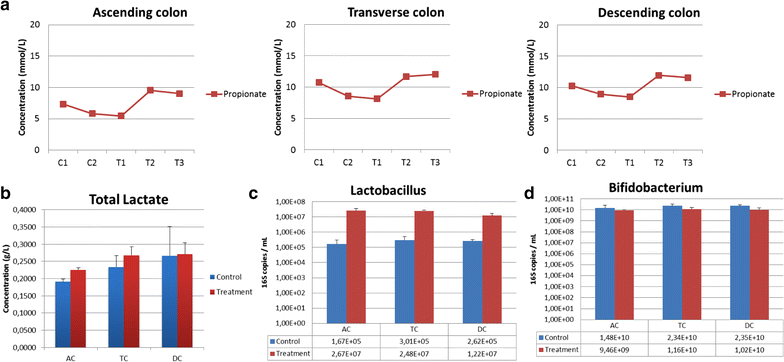Experimental support for the effects of a probiotic/digestive enzyme supplement on serum cholesterol concentrations and the intestinal microbiome
- PMID: 27333764
- PMCID: PMC4918082
- DOI: 10.1186/s12967-016-0945-2
Experimental support for the effects of a probiotic/digestive enzyme supplement on serum cholesterol concentrations and the intestinal microbiome
Abstract
Background: Elevated levels of blood cholesterol are associated with cardiovascular disease, a leading cause of morbidity and mortality worldwide. Current therapies for addressing elevated blood cholesterol can be inadequate, ineffective or associated with side effects; therefore, the search for additional therapies is ongoing. This study evaluated Daily Body Restore (DBR), a proprietary blend of 9 probiotic organisms of the genera Lactobacillus and Bifidobacterium, and 10 digestive enzymes, for its effects on cholesterol metabolism using an in vitro system and a mouse model.
Methods: We used a murine model of hypercholesterolemia induced by a high fat diet to evaluate the effects of DBR on blood cholesterol concentrations. Hypercholesterolemic mice were supplemented with DBR in their drinking water for 8 weeks and compared to control mice given low fat diets or unsupplemented high fat diets. To evaluate the effects of DBR on the activity of gut microbiota in vitro, the Shime(®) system consisting of sequential colon reactors was supplemented with DBR for analysis of short chain fatty acid production.
Results: Analysis of hypercholesterolemic mice after 4 and 8 weeks of DBR supplementation revealed significant decreases in blood concentrations of low-density lipoprotein (LDL) and increases in high-density lipoprotein (HDL) while triglyceride concentrations were unaltered. Specifically, after 4 weeks of DBR supplementation, there was a 47 % decrease in LDL and a 32 % increase in HDL in peripheral blood compared to unsupplemented, high fat diet-fed mice. After 8 weeks of DBR treatment, LDL concentrations were dramatically reduced by 78 % and HDL was increased by 52 % relative to control mice. Addition of DBR to the Shime(®) system led to significantly increased production of propionate in colon reactors, indicative of microbial production of short chain fatty acids known to inhibit cholesterol synthesis.
Conclusions: DBR, a probiotic and digestive enzyme supplement, lowered harmful LDL and increased HDL levels in a mouse model and also exerted in vitro effects consistent with cholesterol-lowering activity. Given the magnitude of the effects of DBR, these findings are promising for clinical implementation of DBR for treating hypercholesterolemia.
Keywords: Cholesterol; Digestive enzyme; Low-density lipoprotein; Probiotic.
Figures


Similar articles
-
Effect of supplementation of probiotics and phytosterols alone or in combination on serum and hepatic lipid profiles and thyroid hormones of hypercholesterolemic rats.J Dairy Sci. 2013 Jan;96(1):9-15. doi: 10.3168/jds.2012-5442. Epub 2012 Nov 22. J Dairy Sci. 2013. PMID: 23182355
-
Therapeutic effect of probiotic dahi on plasma, aortic, and hepatic lipid profile of hypercholesterolemic rats.J Cardiovasc Pharmacol Ther. 2013 Sep;18(5):490-7. doi: 10.1177/1074248413487431. Epub 2013 May 12. J Cardiovasc Pharmacol Ther. 2013. PMID: 23671271
-
Lactobacillus fermentum FTDC 8312 combats hypercholesterolemia via alteration of gut microbiota.J Biotechnol. 2017 Nov 20;262:75-83. doi: 10.1016/j.jbiotec.2017.09.007. Epub 2017 Sep 19. J Biotechnol. 2017. PMID: 28935567
-
Meta-Analysis: Effects of Probiotic Supplementation on Lipid Profiles in Normal to Mildly Hypercholesterolemic Individuals.PLoS One. 2015 Oct 16;10(10):e0139795. doi: 10.1371/journal.pone.0139795. eCollection 2015. PLoS One. 2015. PMID: 26473340 Free PMC article. Review.
-
Reduction of low density and high density lipoprotein cholesterol by fat-modified diets. A survey of recent findings.Hum Nutr Clin Nutr. 1982;36(3):203-11. Hum Nutr Clin Nutr. 1982. PMID: 6749766 Review.
Cited by
-
Metagenomic Analysis of Duodenal Microbiota Reveals a Potential Biomarker of Dysbiosis in the Course of Obesity and Type 2 Diabetes: A Pilot Study.J Clin Med. 2020 Jan 29;9(2):369. doi: 10.3390/jcm9020369. J Clin Med. 2020. PMID: 32013181 Free PMC article.
-
Microbiota-derived short-chain fatty acids: Implications for cardiovascular and metabolic disease.Front Cardiovasc Med. 2022 Aug 11;9:900381. doi: 10.3389/fcvm.2022.900381. eCollection 2022. Front Cardiovasc Med. 2022. PMID: 36035928 Free PMC article. Review.
-
Effects of Maternal Pre-Pregnancy BMI on Preterm Infant Microbiome and Fecal Fermentation Profile-A Preliminary Cohort Study.Nutrients. 2025 Mar 11;17(6):987. doi: 10.3390/nu17060987. Nutrients. 2025. PMID: 40290029 Free PMC article.
-
Gut microbiota metabolites, redox status, and the related regulatory effects of probiotics.Heliyon. 2023 Oct 29;9(11):e21431. doi: 10.1016/j.heliyon.2023.e21431. eCollection 2023 Nov. Heliyon. 2023. PMID: 38027795 Free PMC article. Review.
-
The Potential Role of Gut Microbiota in the Prevention and Treatment of Lipid Metabolism Disorders.Int J Endocrinol. 2020 Sep 14;2020:8601796. doi: 10.1155/2020/8601796. eCollection 2020. Int J Endocrinol. 2020. PMID: 33005189 Free PMC article. Review.
References
-
- Mann GV. Studies of a surfactant and cholesteremia in the Maasai. Am J Clin Nutr. 1974;27(5):464–469. - PubMed
MeSH terms
Substances
LinkOut - more resources
Full Text Sources
Other Literature Sources
Medical

